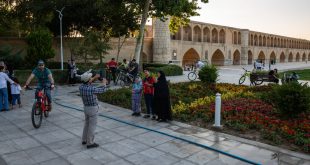It’s the film that inspired a generation: the flying kicks, the furious punches, the whirlwind sound effects.
Fist of Fury is the classic 1972 Bruce Lee film that took the world by storm.
Tragically, Lee died a year after making it, aged just 32.
But his films have had an enduring global impact, not least on a family of Indigenous Noongar people in Australia.
And now, in a world first, Fist of Fury has been dubbed into the Noongar language.
“I love everything Bruce Lee stands for,” director Kylie Bracknell tells Al Jazeera. “As we say in our community, actions speak louder than words.”
A self-confessed Bruce Lee fan, Bracknell recalls watching his films with her brothers and having film posters on the bedroom walls at home.
Bracknell – whose Indigenous cultural name is Kaarljilba Kaardn – says she admired not only the martial arts master’s kung fu skills but also his philosophy and approach to life.
 Noongar speakers worked with Cantonese speakers from Hong Kong on the translation and dubbing [Courtesy Perth Festival]
Noongar speakers worked with Cantonese speakers from Hong Kong on the translation and dubbing [Courtesy Perth Festival]
It was these traits that also correlated with her own Noongar culture, inspiring her to produce Fist of Fury dubbed into her traditional language.
But the project is not just about novelty.
Indigenous languages in the continent now known as Australia have been under threat since the British began colonisation in 1788.
In a recent article, Jane Simpson, chair of Indigenous Linguistics at the Australian National University, noted that between 300 and 700 languages were previously spoken on the continent.
The last census in 2016 revealed only 160 of those languages were still spoken at home.
“And of these, only 13 traditional Indigenous languages are still spoken by children,” Simpson said. “It means that in 60 years’ time only 13 of Australia’s languages will be left, unless something is done now to encourage these children to keep speaking their language.”
Journey of discovery
Bracknell’s own language journey began when she was 13 years old, after her grandfather passed away.
 Kylie Bracknell became interested in the Indigenous Noongar language when she was 13, learning from her grandmother’s sisters [Courtesy Perth Festival]
Kylie Bracknell became interested in the Indigenous Noongar language when she was 13, learning from her grandmother’s sisters [Courtesy Perth Festival]
She recalls noticing various language books in his house, and asked her grandmother why her family did not speak their original language of Noongar.
Her grandmother explained that she had been sent away at aged 14 to work for a white family and had “no chance” of retaining her culture and language from older family members, a time when the Australian government’s assimilation policy attempted to stamp out diverse Indigenous cultures and languages across the continent.
But Bracknell was determined, and her desire to learn her original language led her to visit some relatives who still retained their Noongar language.
“So I sat with my grandmother’s sisters and learnt our language,” she says.
“At that point, I had no idea that, in 2021, I would be premiering a dub of a Bruce Lee film. I simply just wanted to connect the missing parts to who I am and make sense of why that part of our cultural identity had been suppressed.”
She says she learned that the hard way – being told off and being “growled at” by the older people in the group.
But Bracknell soon realised these were simply methods for raising children in their way, and just like Bruce Lee’s philosophy, testing her mettle to make her stronger.
“I just wanted to them proud, and in order to do old people proud you must listen and you must take things on the chin,” she says. “They are giving you their time and energy because they care and because they also want you to make them proud.”
February 21 marks the United Nations’ International Mother Language Day, which celebrates and aims to preserve the world’s diverse languages.
The UN has said that as many as 43 percent of the world’s 6,000 languages are currently under threat, many of them Indigenous languages. Although Indigenous peoples make up less than 6 percent of the global population, they speak more than 4,000 of the world’s languages.
Such languages – like Noongar – are under threat as a result of colonisation and past and present policies which – intentionally or not – contribute to the erosion of Indigenous languages.
Bracknell tells Al Jazeera that she did not speak Noongar publicly until she was 24 years old, when she began to work in theatre companies in Western Australia. She would eventually produce a Noongar version of Shakespeare’s Macbeth, titled Hecate, which premiered at the Perth Festival last year.
“I always wanted to do legitimate research and really put my heart into being able to speak it with that ancient tone, with the very essence of how my teachers spoke it, before I shared it,” she says.
 The team works on the dubbing – trying to ensure the mouth movements of the original and Noongar versions match [Courtesy Perth Festival]
The team works on the dubbing – trying to ensure the mouth movements of the original and Noongar versions match [Courtesy Perth Festival]
The Fist of Fury project, Bracknell says, was inspired by a 2013 Navajo-dubbed release of Star Wars Episode IV: A New Hope.
However, she did not want to repeat Star Wars and felt that Bruce Lee film “would reach all generations” and was “something a little more art house”.
Most importantly, though, Bracknell felt that Fist of Fury was a film that “really speaks to the physical expression that we honour in our language. It’s not just about what comes out of your mouth but your body expression.”
“Too many people consider language is a spoken form. They forget that our language is in your physical expression,” she says. “That is what informed the choice of Bruce Lee and kung fu.”
Challenge of translation
Dubbing the film was no easy task.
“All of it proved challenging to translate because you are responsible for an interpretation,” Bracknell recalled. “And you are responsible for honouring the meaning of the original text and original conversations.”
“The difficulty with the dub is that you must match the onscreen performers’ mouth movement. It’s not just about the difficulty of translation, but the fine art of giving the onscreen actor the gravitas and the power that they have in their mother tongue.”
The production team worked with a native Cantonese translator from Hong Kong, to ensure the correct translation process, which proved a meticulous process.
“We are working with arguably the most sophisticated language in the world – Cantonese – and so they are going to expect that we do this properly,” she says. “It’s their story, it’s their film.”
The process proved rewarding for their research on the Noongar language, for example, finding a word for “older brother” that they were previously unaware of.
 Bracknell believes dubbing classic films into Indigenous languages can help people to feel proud of their culture [Courtesy Perth Festival]
Bracknell believes dubbing classic films into Indigenous languages can help people to feel proud of their culture [Courtesy Perth Festival]
Such language reclamation and survival projects are slowly being implemented in Australia as the cultural and social importance of language become better recognised.
A programme was recently established in Western Australian prisons with diverse regional languages to be taught where most appropriate.
“There is an intrinsic link between language and culture so this new programme aims to help Aboriginal prisoners reconnect with their own people, practices and beliefs,” Corrective Services Minister Francis Logan said in a media statement.
“Research shows that teaching Aboriginal languages leads to positive personal and community development outcomes, including good health and wellbeing, self-respect, empowerment, cultural identity, self-satisfaction and belonging.”
That such a programme is required to be delivered in prisons – as opposed to schools – is evidence of the continuing negative effect that colonisation has had on Indigenous communities, with a young Aboriginal person more likely to go to prison than university.
Given this, Bracknell says that projects such as Fist of Fury are “really important because they are the very thing that is going to excite, inspire and motivate our younger generation to feel proud about what they have and about what the generations before them have been able to protect and pass on.
“They see their own people embracing it,” she says. “They see real people – and it’s their people, from their community – embracing the language and enjoying the joy that comes from it.”
 Top Naija News: Nigerian News, Breaking News Nigeria and World News Top Naija News is a daily news publication in Nigeria, delivering the latest breaking news in Nigeria and around the world.
Top Naija News: Nigerian News, Breaking News Nigeria and World News Top Naija News is a daily news publication in Nigeria, delivering the latest breaking news in Nigeria and around the world.




